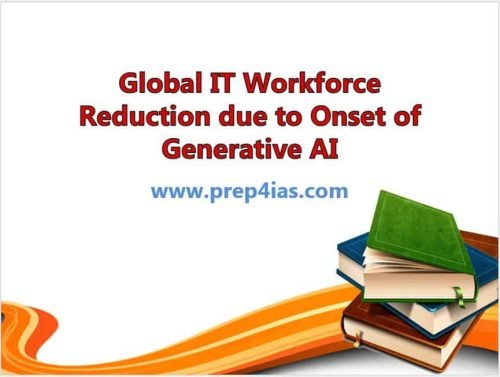The global IT workforce is experiencing significant transformations due to the onset of generative AI. An IBM study found that productivity is now the highest business priority for nearly half of the CEOs surveyed, up from sixth place in 2022. CEOs recognize technology modernization, including the adoption of generative AI, as key to achieving their productivity goals.
However, challenges such as data security concerns, potential bias, and ethical considerations are notable. Despite these concerns, three-quarters of CEOs believe that competitive advantage will depend on the most advanced generative AI. Interestingly, there's a disconnect between CEOs and their teams regarding AI readiness, with only 29% of executive teams believing they have the in-house expertise to adopt generative AI.

Global IT Workforce Reduction due to Onset of Generative AI
Also Read: Mounjaro - Newly approved medication for Type 2 Diabetes Treatment
Generative AI is already influencing workforce dynamics. About 43% of CEOs surveyed have reduced or redeployed their workforce due to generative AI, and an additional 28% plan to do so in the next 12 months. Conversely, 46% have hired additional workers because of generative AI, indicating a shift in the type of workforce required. However, less than one-third of CEOs have assessed the potential impact of generative AI on their workforces.
World Economic Forum(WEF) Report
As cited in IBM's study, the WEF estimated that between 2020 and 2025, around 85 million jobs globally would be disrupted by AI, but this would also lead to the creation of 97 million new job roles. The WEF's predictions align with other findings, suggesting substantial workforce disruptions and skill shifts due to AI.
McKinsey & Company Report
According to McKinsey's annual global survey on AI, one-third of respondents stated their organizations are regularly using generative AI in at least one business function. The report also highlighted that AI adoption has moved from being a purely technical subject to a top agenda item for company leaders and boards. The survey predicted significant workforce changes, including cuts in some areas and large reskilling efforts.
Goldman Sachs Report
A report by Goldman Sachs estimates that AI could replace the equivalent of 300 million full-time jobs, significantly affecting labor in the US and Europe. It's predicted that two-thirds of jobs in these regions are exposed to some degree of AI automation. Additionally, an MIT and Boston University report suggests that AI will replace as many as two million manufacturing workers by 2025. The McKinsey Global Institute reports that by 2030, at least 14% of employees globally may need to change their careers due to advancements in AI, robotics, and digitization.
Drop in STEM skills
The need for STEM skills has dropped significantly, with technology becoming more user-friendly and employees able to do more with less advanced technical skills. Skills like time management, teamwork, and effective communication are rising in importance. This shift indicates that while technical skills remain important, the focus is increasingly on skills that facilitate the use of AI in more strategic and creative ways.
These findings suggest that generative AI is not only leading to workforce reductions in certain areas but also creating new job roles and necessitating significant reskilling efforts. The impact is particularly pronounced in industries and job roles most susceptible to automation. As AI technologies evolve, they are expected to bring about substantial.
Most Vulnerable Jobs
The most vulnerable jobs due to the onset of Generative AI tend to be those involving routine, repetitive tasks or roles that can be automated through advanced algorithms. These include:-
- Desktop Support and System Admin Roles: Jobs that involve basic desktop support and administration are highly susceptible to automation by AI. This is already evident with the recent announcement of job cuts in multiple global organizations.
- Basic Customer Service: AI can handle customer inquiries and provide responses, reducing the need for human customer service representatives for standard queries.
- Content Creation: Generative AI can produce written content, graphics, and even code, which might impact jobs in content writing, graphic designing, and basic software development. So going ahead it will definitely impact the content creators like LinuxNasa, ItsFossLinux, Socialyzehub, Promarkaff etc.
- Analysis and Reporting: Jobs that involve standard analysis and reporting can be automated using AI that can analyze large datasets and generate reports.
- Telemarketing and Sales: AI can automate certain sales processes and telemarketing tasks, affecting sales roles that don't require deep expertise or complex negotiations.
Way Ahead
The way ahead for addressing the global reduction in the IT workforce due to the onset of Generative AI involves several key strategies:-
- Reskilling and Upskilling: Investing in education and training programs to help workers acquire new skills that are in demand in the AI-driven job market.
- Emphasis on Human-Centric Skills: Focusing on skills that AI cannot replicate, such as emotional intelligence, creativity, and strategic thinking.
- Job Redesign: Adapting and redesigning jobs to incorporate AI tools while leveraging human expertise.
- Promoting AI Ethics and Governance: Ensuring responsible use of AI to mitigate negative impacts on the workforce.
- Innovation and New Job Creation: Encouraging innovation that can lead to the creation of new job roles and industries in the AI era.
